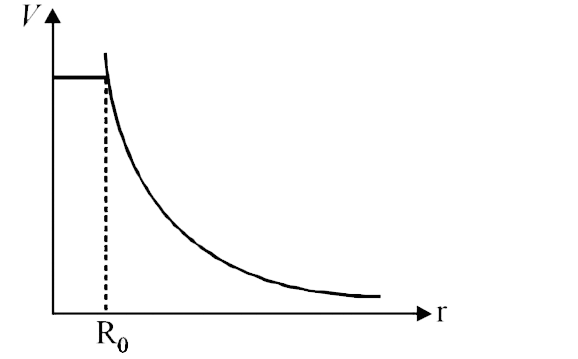The Bohr model for the H-atom relies on the Coulomb's law of electrostatics . Coulomb's law has not directly been varified for very short distances of the order of angstroms. Suppos-ing Coulomb's law between two oppsite charge +q1,−q2 is modified to ∣∣→F∣∣=q1q2(4πε0)r21r2,r≥R0
=q1q2(4πε0)r21R20(R0r)ε,r≤R0
Calculate in such a case , the ground state enenergy of H-atom , if ε=0.1,R0=1Å
−11.4
−17.3
5.9
−23.2
The correct Answer is:A
Given ε=0.1,R0=1Å, Let ε=2+δ
In case of H-atom ,
q1q24πε0=(1.6×10−19)2(9×109)=2.3×10−28Nm2
It is given that (1R20)(R0r)ε=(1R20)(R0r)2+δ=Rδ0r2+δ
Thus, F=xRδ0r2+δ (∵x=q1q24πε0)
As F=mv2r⇒mv2r=xRδ0r2+δ or v2=xRδ0mr1+δ...(i)
(i)As mvr=nħ⇒r=nħmv
Using eqn (i) r=nħm[mxRδ0]1/2r(1+δ)2
or r(1+δ)/2=(n2ħ2mxRδ0)1/2∴r=(n2ħ2mxRδ0)1/(1−δ)
For n=1, r1=(ħ2mxRδ0)1/(1−δ)
=⎡⎣(1.05×10−34)2(9.1×10−31)(2.3×10−23)(1019)⎤⎦12.9
=8×10−11m=0.8Å
(ii)From vn=nħmrn=nħ(xRδ0n2ħ)11−δ
for n=1,v1=ħmr1=1.44×106ms−1
(iii) K.E. =12mv21=9.43×10−19J=5.9eV
(iv)P.E. of electron from ∞ to R0 ,U1=14πε0(q1q2R0)=−xR0
P.E. of electron from R0 to r, U2=−∫rR0Fdr
=xRδ0∫rR0dr2+δ=xRδ0r1+δ∣∣∣1r1+δ∣∣∣rR0=−x(1+δ)[Rδ0r1+δ−1R0]
Total P.E. of electron P.E. =−x1+δ[Rδ0r1+δ−1R0+1+δR0]
=−2.3×10−280.9[Rδ0r1+δ−δR0]=−2.3×10−280.9[R−190r−0.9−1.9R0]
=−2.3×10−28−0.9⎡⎢⎣(0.8)0.910−10×(−1.9)−1.910−10
=2.3×10−280.9×10−10[(0.8)0.9−1.9]=−17.3eV
Total energy E=KE+PE=5.9−17.3eV=−11.4eV.
Topper's Solved these Questions
- BOOK - NCERT FINGERTIPSCHAPTER - ATOMS EXERCISE - NCERT Exemplar7videos
ATOMS
- BOOK - NCERT FINGERTIPSCHAPTER - ATOMS EXERCISE - Assertion And Reason15videos
ATOMS
- BOOK - NCERT FINGERTIPSCHAPTER - ATOMS EXERCISE - De Broglie Explanation Of Bohr Model3videos
ATOMS
- BOOK - NCERT FINGERTIPSCHAPTER - ALTERNATING CURRENT EXERCISE - Assertion And Reason15videos
ALTERNATING CURRENT
- BOOK - NCERT FINGERTIPSCHAPTER - COMMUNITCATION SYSTEMSEXERCISE - HOTS10videos
COMMUNITCATION SYSTEMS
Similar Questions
The Bohr model for the H-atom relies on the Coulomb's law of electrostatics . Coulomb's law has not directly been varified for very short distances of the order of angstroms. Suppos-ing Coulomb's law between two oppsite charge +q1,−q2 is modified to ∣∣→F∣∣=q1q2(4πε0)r21r2,r≥R0
=q1q2(4πε0)r21R20(R0r)ε,r≤R0
Calculate in such a case , the ground state enenergy of H-atom , if ε=0.1,R0=1ÅView Solution41.Self energy of conducting sphere of radius r carrying charge is (1) Q28πε0(r) (2) Q24πε0(r) (3) Q26πε0(r) (4) Q22πε0(r)
View Solution
Knowledge Check
- Question 1 - Select One
The electrostatic force between two point charges q1 and q2 at separation r is given by F=k.q1q2r2. The constant k
ADepends upon system of units onlyBDepends upon medium between the chargesCDepends on both 1 and 2DIs independent of both 1 and 2 - Question 2 - Select One or More
A spherical symmetric charge system is centered at origin. Given, Electric potential
V=Q4πε0R0(r≤R0), V=Q4πε0r(r>R0)
 A(a) Within r=2R0 total enclosed net charge is QB(b) Electric field is discontinued at r=R0C(c) Charge is only present at r=R0D(d) Electrostatic energy is zero for r<R0
A(a) Within r=2R0 total enclosed net charge is QB(b) Electric field is discontinued at r=R0C(c) Charge is only present at r=R0D(d) Electrostatic energy is zero for r<R0
If Coulomb's law involved 1r3 (instead of 1r2), would Gauss's law still be true?
View SolutionThe vector form of Coulomb's law is (A) →F=14πε0⋅q1q2|→r|3→r (B) →F=14πε0⋅q1q2r3 (C) →F=14πε0⋅q1q2r2→r (D) →F=14πε0⋅q1q2r→r
View SolutionThe vector form of Coulomb's law is (A) →F=14πε0⋅q1q2|→r|3→r (B) →F=14πε0⋅q1q2|→r|3 (C) →F=14πε0⋅q1q2r2→r (D) →F=14πε0⋅q1q2r→r
View SolutionEvaluate ∫r2r1(r−ηq0qr2)dr
View SolutionA charge q1 is placed at the centre of a spherical conducting shell of radius "R" .Conducting shell has a total charge q2 .Electrostatic potential energy of the system is (A) q21+2q1q28πɛ0R (B)q22+2q1q28πɛ0R (C) q21+q1q28πɛ0R (D) q22+q1q28πɛ0R
View SolutionWrite an expression for potential at a point P −→(r) due to two point charges q1andq2 at →r1and→r2 respectivley.
View Solution

